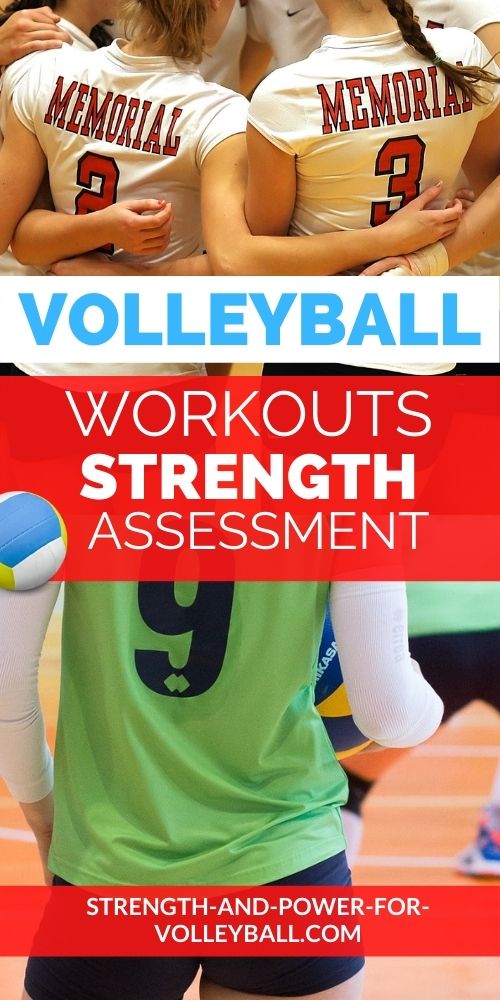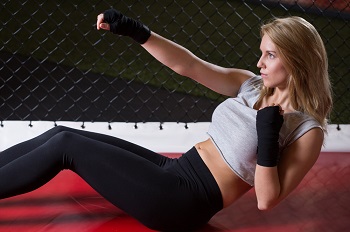Volleyball Workouts at Home
Assessing Strength for Volleyball
Volleyball workouts at home can be a challenge for any athlete.
Effective strength programs involve applying assessment strategies and being in touch with specific needs at every stage of strength development.
Why Test Functional Strength
Assessing basic functional strength. Functional strength tests are necessary because without adequate strength, correct strength training technique will be compromised and injury is more likely.
Also, like any athlete, a volleyball player that isn't functionally strong, will find a way to make plays through poor biomechanics while enhancing unwanted compensation patterns through the repetition of playing their sport.
No cookie cutter programming. Every athlete has their own unique strengths and weaknesses. Designing the same exact workout for each player on a volleyball team isnt going to cut it.
If you're not assessing, you're just guessing.
Every athlete is different. Therefore, volleyball workouts should be built around the athlete, not the other way around.
If you enjoyed these tips and would like to keep it close to you at any time, just save this pin to your Pinterest Volleyball Training Board.
Strength training isn't just for practice or the weight room. Many players can perform volleyball workouts at home.
Upper Body Functional Strength
Three basic tests for upper-body functional strength. If you can't perform body-weight exercises such as pull-ups and push-ups then you're not functionally strong and are more likely to get injured.
- Push-ups. Why use the push-up test instead of the bench press to determine your volleyball workouts? The bench press is good for determining general upper-body strength, but we care about functional strength. The bench press is considered less functional mainly because the bench is helping stabilize your core. The bench press may also be considered open chained (because the hands are moving during the exercise) and the push-up may be considered closed-chained (because the hands don't move). Push-ups use all the muscles that make up the shoulder girdle and strengthen the little stabilizer muscles of the shoulder. Push-ups are often considered difficult because the core stabilizer muscles of the hips and shoulders must be used to balance the body.
| Maximum Push-up Test |
|
Dont count reps where the body doesnt stay in alignment, nose doesnt touch the ground, or elbows arent fully extended. To make counting easier and prevent cheating, use a metronome set at 50 beats a minute. The athlete should keep pace with the metronome, going up on the first beat, and down on the next. The test is over when the athlete cant do another push-up or cant keep up with the metronome.
|
For volleyball workouts at home, push ups are a great workout.
Pull-ups. Like push-ups, pull-up strength is important to keeping
athletes that use overhead motions injury free. Athletes that can't do
pull-ups aren't functionally strong and are more likely to have problems
at the rotator cuff. Push-ups, pull-ups, and rows are all good for
strengthening volleyball players shoulders and can be done during
volleyball workouts.
| Maximum Pull-up Test |
|
Dont count any reps where the athlete doesnt get full extension or the chin doesnt get above the bar.
|
Pull ups are another great exercise for volleyball workouts at home.
Inverted-rows. Many volleyball players volleyball workouts at home consist of more pushing exercises than pulling exercises. By simply adding rows to your volleyball workouts, you can then gain strength that corrects these muscular imbalances. It's not unusual for athlete's to make increases in bench press strength just by correcting these imbalances.
| Maximum Inverted Row Test |
|
|
One-arm Row
Lower-body functional strength tests. There really isn't an easy way to test lower body functional strength. The one-leg box squat may be the best exercise to test lower body functional strength.
Athletes untrained in single leg strength should progress slowly through
their training insuring they are performing the exercises safely.
Untrained
athletes should start first with Split Squats and Bulgarian Split
Squats (back foot up on an elevated surface) before attempting more
advanced one-leg squat variations like the one-leg box squat.
Vertical jump. An alternative to testing functional lower body strength may be to test vertical jumping power. You could test lower body leg power by doing a vertical jump test before starting a functional strength training program, then reassess your progress at the end your volleyball workouts training cycle.
Another option for testing power may be to perform power exercises such as cleans and snatches. 1RM testing power exercises such as the power clean isn't appropriate because of the difficulty of performing a maximum lift with proper technique.
Therefore, it is better to perform multiple-RM tests in order to estimate the 1RM of the power exercises.
Volleyball Workouts at Home Related Pages
Volleyball › Smarter Training › Volleyball Workouts at Home

